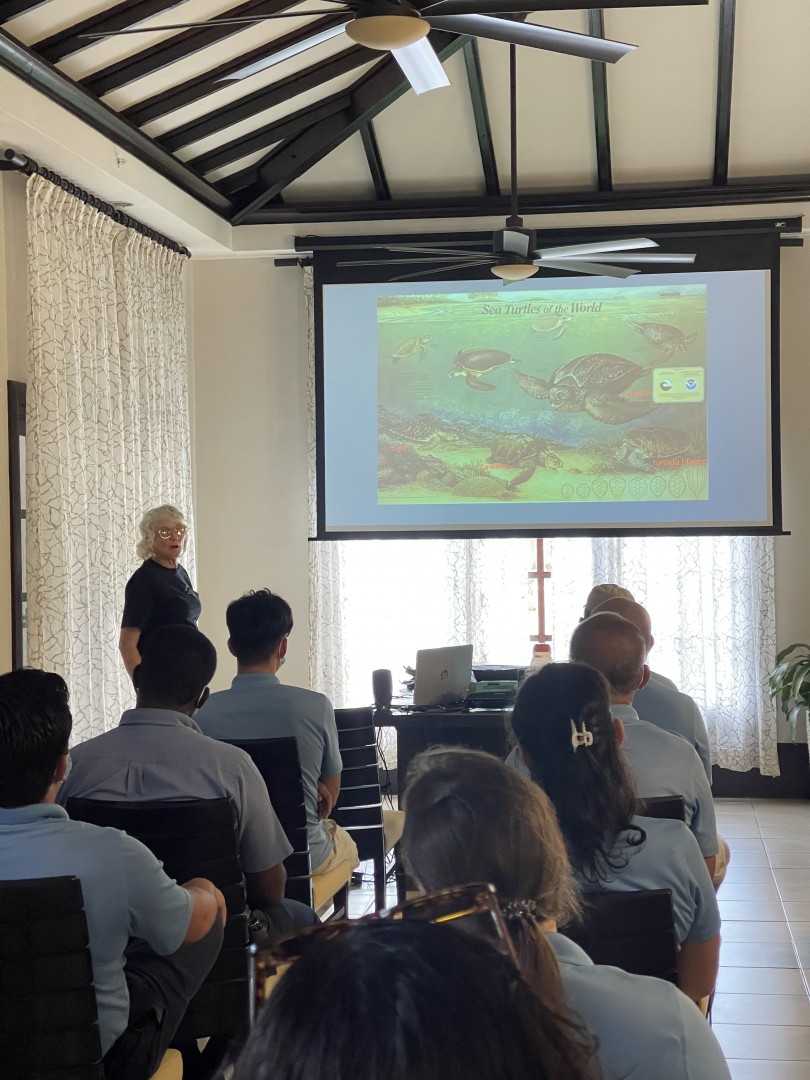
Sea turtle nesting season in Aruba runs from March through September each year. In anticipation of welcoming multiple nests on our Eagle Beach, we call upon resident expert and tireless champion of the turtles, Mrs. Edith van der Wal.
 Edith conducts seminars for all of our associates and guests are invited, too. Everyone learns how to spot a new nest and the actions to take in protecting it for the 60-70 day incubation period until the hatchlings emerge. For example, by protecting nests by leaving them undisturbed, on average, 90% of the clutch (nest of eggs) can successfully hatch. If disturbed by humans or predators, only 25% may hatch.
Edith conducts seminars for all of our associates and guests are invited, too. Everyone learns how to spot a new nest and the actions to take in protecting it for the 60-70 day incubation period until the hatchlings emerge. For example, by protecting nests by leaving them undisturbed, on average, 90% of the clutch (nest of eggs) can successfully hatch. If disturbed by humans or predators, only 25% may hatch.
While four types of giant sea turtles nest all around Aruba's coastline, including the loggerhead, the hawksbill, and the green turtle, we see the leatherback turtle nests on Eagle Beach.
Fun facts about leatherback sea turtles:
- It is the largest existing sea turtle (Dermochelys coriacea)
- It is distinguished by its flexible carapace composed of a mosaic of small bones embedded in a thick leathery skin.
- The leatherback life cycle begins with a female turtle laying eggs on a nesting beach. Females stay close to shore in “inter-nesting habitats” for 3-4 months and make repeated visits at 10-day intervals to lay eggs.
- Adult females depart for pelagic habitats to forage and remain there for an average “remigration interval” of 2-5 years until they return to nest once again.
- About 60-70 days after the female lays eggs, hatchling turtles emerge from their nests. They use a temporary tooth to begin breaking through their shell. That process combined with climbing up to the surface of the sand can take a few days. Once there, using their internal magnetic compass, they sense their way directly to the sea.
- They then follow ocean currents to pelagic nursery habitats, where they search for food and seek refuge from predators.
- Scientists refer to this time period as “the lost years”, since finding hatchlings and juveniles to study in the open ocean is difficult.
- After 15-25 years, leatherbacks reach maturity. Mature female turtles return to their natal beaches for nesting, but adult male turtles live entirely at sea.
Follow the nesting season on our website:
Last year we created a Sea Turtle Nesting calendar webpage to inform our guests when and where turtle nests have been laid, and when they are expected to hatch. You are able to see last year's nest locations and we await our first nest to update this page for the 2022 season.
Click HERE to view the Sea Turtle Nesting page.

 Edith conducts seminars for all of our associates and guests are invited, too. Everyone learns how to spot a new nest and the actions to take in protecting it for the 60-70 day incubation period until the hatchlings emerge. For example, by protecting nests by leaving them undisturbed, on average, 90% of the clutch (nest of eggs) can successfully hatch. If disturbed by humans or predators, only 25% may hatch.
Edith conducts seminars for all of our associates and guests are invited, too. Everyone learns how to spot a new nest and the actions to take in protecting it for the 60-70 day incubation period until the hatchlings emerge. For example, by protecting nests by leaving them undisturbed, on average, 90% of the clutch (nest of eggs) can successfully hatch. If disturbed by humans or predators, only 25% may hatch.